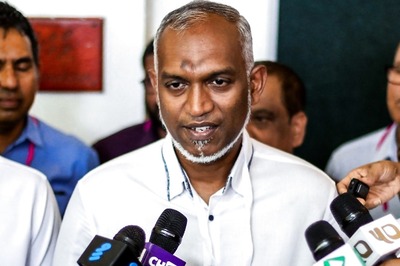
views
The attempted intrusion in Yangtze in the Tawang sector of Arunachal Pradesh by a large, well-prepared and armed with handheld weapons Chinese PLA group, late in the night of 9-10 December 2022, was a coordinated action, intending to exploit adverse weather conditions to grab crucial Indian territory. The aim was to alter the status quo of the Line of Actual Control (LAC) by taking control of a peak which could provide it with observation into depth areas and also deny Indians observation into China.
Yangtze is one of the 25 recognised disputed points between the two countries, though China has been claiming complete Arunachal Pradesh as a part of southern Tibet. These regions have been identified through either working group dialogues, the exchange of maps or Chinese PLA actions. Yangtze, located 25 km from Tawang, has remained a major friction point between the two nations.
The Chinese build-up, exploiting its border villages in the vicinity, was observed by Indian troops who moved reserves close to the location to counter any possible misadventure, keeping them hidden from Chinese observation. When Chinese troops crossed the LAC and attempted to assault Indian sentries, Indian reserves quickly mobilised and counter-attacked the Chinese. Hand-to-hand combat ensued and the Chinese were forced back with large numbers of physical casualties. Indian troops also suffered a few injuries which, as per the defence minister, were ‘not serious.’
While Indian figures are available, China, as expected, continues to hide its casualty figures. It would, a month or two down the line, mention one or two injured. It has been the Chinese norm to downplay its losses, solely to protect the image of the PLA.
The next day there was a ‘flag meeting’ between the two commanders and normalcy was restored. It was another planned Chinese assault failing. This was the first serious physical clash after Galwan. Yangtze is an important height held by India and it provides good observation into the Chinese bowl. In case occupied by China, it would open observation onto the Indian side. There is also a spring on the Chinese side of the LAC, which is sacred to Buddhists and has been closed to all, Indian and Chinese citizens, for the past few years.
Every year, China attempts to invade the region to stake its claim, exploiting differing perceptions of the LAC. There was a standoff in October 2021, when a Chinese patrol similarly crossed the LAC. It was diffused within a few hours. The Chinese strength then was around 100 but was 300 this time and better armed. The last physical clash in this region was in 2016. In winters, India reduces its deployment in the region due to maintenance issues, which the Chinese attempted to take advantage of. However, it was not to be. Not only were the Chinese pushed back but Indian soldiers followed the Chinese into their territory, causing panic.
While the Indian media broke the news on 12 December, three days after the incident, the Chinese media maintained silence. It was only after a statement was issued by the defence minister in both houses of Parliament were the Chinese forced to react. The Chinese military spokesperson stated, ‘PLA was carrying out a regular patrol in Dongzhong area and was blocked by Indian Army illegally crossing the LAC.’ The Chinese foreign office spokesperson added that the ‘situation has stabilised’.
This implies that China may have attempted to exploit the reduced Indian deployment, which it could then convert into a victory, but the pushing back of its troops forced it into an embarrassed silence. Had India not announced the incident, China would have maintained ignorance. China has, despite larger losses and pullback, been projecting Galwan as a victory. It continues to blame India for the incident as it has done in the case of Yangtze, not that it matters as India strictly adheres to the LAC.
Chinese offensive moves towards grabbing Indian territory have been ongoing for years. There have been standoffs and minor clashes whenever the patrols have come into contact. However, most cases were resolved either through diplomatic parleys or local commander-level talks. General Bipin Rawat had stated in September 2017, ‘As far as the Northern adversary is concerned, flexing of muscles has started. Salami slicing, taking over territory in a very gradual manner, testing our limits or threshold is something we have to be wary about.’
The Chinese philosophy appears to be to occupy disputed land, prolong discussions, refuse to withdraw, develop infrastructure and finally alter the status quo.
India has, as a precaution, enhanced its troop density in the region. It is almost similar to the scenario in Ladakh, where our troop deployment is high as the scenario remains tense and uncertain. The question to consider is whether additional deployment in regions where clashes occur is the new norm. This is not a logical solution for the long term. While the Chinese have built habitat and also border villages, which act as staging points, Indian troops would initially be at an administrative disadvantage till habitat is constructed.
India needs to understand the Chinese motive and plan similar actions on the Chinese side.
Further, employing 300 troops, armed with weapons, deployed in two waves, to grab a peak or project their claim line would require clearance from Beijing. It would be beyond the power of the Chinese Western Theatre commander.
This implies that Beijing continues to display an offensive mindset aimed at pushing India to move its troops outwards and also altering the LAC. The fact remains that for China, India is an adversary that it must embarrass and display in poor light if it seeks to project itself as the sole power in Asia. The troops armed with drones to video film their operation only justifies that their intent was to embarrass India.
Reduction in India-China diplomatic engagement has had no impact in changing Chinese behaviour. India needs to move beyond, possibly on the economic front or enhance its role in the Quad to send a message that it will continue to stand up to China.
The author is a retired Major General of the Indian Army. Views expressed are personal.
Read all the Latest Opinions here















Comments
0 comment